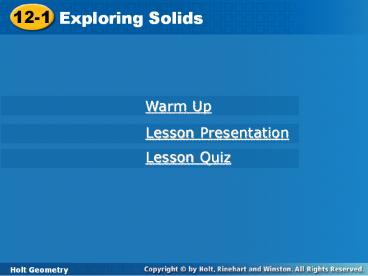Exploring Solids - PowerPoint PPT Presentation
Title:
Exploring Solids
Description:
12-1 Exploring Solids Warm Up Lesson Presentation Lesson Quiz Holt Geometry 4. A soccer ball resembles a polyhedron with 32 faces; 20 are regular hexagons and 12 are ... – PowerPoint PPT presentation
Number of Views:167
Avg rating:3.0/5.0
Title: Exploring Solids
1
12-1
Exploring Solids
Warm Up
Lesson Presentation
Lesson Quiz
Holt Geometry
2
12.1 Exploring Solids
Warm Up Classify each polygon. 1. a polygon
with three congruent sides 2. a polygon with six
congruent sides and six congruent angles 3. a
polygon with four sides and with opposite sides
parallel and congruent
equilateral triangle
regular hexagon
parallelogram
3
12.1 Exploring Solids
Objectives
Classify three-dimensional figures according to
their properties. Use nets and cross sections to
analyze three-dimensional figures.
4
12.1 Exploring Solids
Vocabulary
face edge vertex prism cylinder pyramid cone cube
net cross section
5
12.1 Exploring Solids
Three-dimensional figures, or solids, can be made
up of flat or curved surfaces. Each flat surface
is called a face. An edge is the segment that is
the intersection of two faces. A vertex is the
point that is the intersection of three or more
faces.
6
12.1 Exploring Solids
A polyhedron is a solid that is bounded by
polygons. Three-dimensional figures, or solids,
can be made up of flat or curved surfaces. Each
flat surface is called a face. An edge is the
segment that is the intersection of two faces. A
vertex is the point that is the intersection of
three or more faces.
7
12.1 Exploring Solids
8
12.1 Exploring Solids
A cube is a prism with six square faces. Other
prisms and pyramids are named for the shape of
their bases.
9
12.1 Exploring Solids
Example 1A Classifying Three-Dimensional Figures
Classify the figure. Name the vertices, edges,
and bases.
cube
vertices A, B, C, D, E, F, G, H
bases ABCD, EFGH, ABFE, DCGH, ADHE, BCGF
10
12.1 Exploring Solids
Example 1B Classifying Three-Dimensional Figures
Classify the figure. Name the vertices, edges,
and bases.
pentagonal pyramid
vertices A, B, C, D, E, F
base ABCDE
11
12.1 Exploring Solids
Check It Out! Example 1a
Classify the figure. Name the vertices, edges,
and bases.
cone
vertex N
M
edges none
base M
12
12.1 Exploring Solids
Check It Out! Example 1b
Classify the figure. Name the vertices, edges,
and bases.
triangular prism
vertices T, U, V, W, X, Y
bases ?TUV, ?WXY
13
12.1 Exploring Solids
A net is a diagram of the surfaces of a
three-dimensional figure that can be folded to
form the three-dimensional figure. To identify a
three-dimensional figure from a net, look at the
number of faces and the shape of each face.
14
12.1 Exploring Solids
Example 2A Identifying a Three-Dimensional
Figure From a Net
Describe the three-dimensional figure that can be
made from the given net.
The net has six congruent square faces. So the
net forms a cube.
15
12.1 Exploring Solids
Example 2B Identifying a Three-Dimensional
Figure From a Net
Describe the three-dimensional figure that can be
made from the given net.
The net has one circular face and one
semicircular face. These are the base and sloping
face of a cone. So the net forms a cone.
16
12.1 Exploring Solids
Check It Out! Example 2a
Describe the three-dimensional figure that can be
made from the given net.
The net has four congruent triangular faces. So
the net forms a triangular pyramid.
17
12.1 Exploring Solids
Check It Out! Example 2b
Describe the three-dimensional figure that can be
made from the given net.
The net has two circular faces and one
rectangular face. These are the bases and curved
surface of a cylinder. So the net forms a
cylinder.
18
12.1 Exploring Solids
19
12.1 Exploring Solids
20
12.1 Exploring Solids
21
12.1 Exploring Solids
22
12.1 Exploring Solids
23
12.1 Exploring Solids
A cross section is the intersection of a
three-dimensional figure and a plane.
24
12.1 Exploring Solids
Example 3A Describing Cross Sections of
Three-Dimensional Figures
Describe the cross section.
The cross section is a point.
25
12.1 Exploring Solids
Example 3B Describing Cross Sections of
Three-Dimensional Figures
Describe the cross section.
The cross section is a pentagon.
26
12.1 Exploring Solids
Check It Out! Example 3a
Describe the cross section.
The cross section is a hexagon.
27
12.1 Exploring Solids
Check It Out! Example 3b
Describe the cross section.
The cross section is a triangle.
28
12.1 Exploring Solids
Example 4A Food Application
A piece of cheese is a prism with equilateral
triangular bases. How can you slice the cheese to
make each shape?
an equilateral triangle
Cut parallel to the bases.
29
12.1 Exploring Solids
Example 4B Food Application
A piece of cheese is a prism with equilateral
triangular bases. How can you slice the cheese to
make each shape?
a rectangle
Cut perpendicular to the bases.
30
12.1 Exploring Solids
Check It Out! Example 4
How can a chef cut a cube-shaped watermelon to
make slices with triangular faces?
Cut through the midpoints of 3 edges that meet at
1 vertex.
31
12.1 Exploring Solids
Lesson Quiz Part I
1. Classify the figure. Name the vertices, edges,
and bases.
32
12.1 Exploring Solids
Lesson Quiz Part II
2. Describe the three-dimensional figure that can
be made from this net.
square pyramid
33
12.1 Exploring Solids
Lesson Quiz Part III
3. Describe the cross section.
a rectangle
34
12.1 Exploring Solids
Lesson Quiz Part IV
4. A soccer ball resembles a polyhedron with 32
faces 20 are regular hexagons and 12 are regular
pentagons. How many vertices does this polyhedron
have?
35
12.1 Exploring Solids
36
12.1 Exploring Solids
Videos Nets of polyhedra
https//www.khanacademy.org/math/cc-sixth-grade-ma
th/cc-6th-geometry-topic/cc-6th-volume-surface-are
a/v/nets-of-polyhedra

